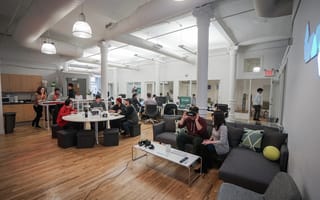
If you build it, they will come.
In just three years, LiveLike has transformed the way sports fans experience live games. Harnessing the power of VR, they’ve virtually teleported fans to major sporting events like the Superbowl, FIFA World Cup and Roland Garros.
And now they’re shifting their focus to their mobile product, which provides fans with rich chat and social widgets that allow them to be an active participant in the live viewing experience — think Twitch, but for sports. We caught up with CTO Saswat Panda, who walked us through the mobile-focused projects his team is working on, and what that means for users.
How has your product evolved since launch?
We founded the company in early 2015 when we realized that VR had the potential to not only provide sports fans with a rich immersive live viewing experience, but also allow fans to truly experience games together regardless of physical boundaries. We took that idea and built the first social sports watching platform in VR, which we showcased most recently with the FIFA World Cup and Fox Sports VR app. Fans could put on VR headsets and find themselves in virtual stadiums watching live sports games while seated and conversing with avatars of their friends.
Over the course of building the VR product, we began to realize that the core problem we were trying to solve — that of deeply connecting fans to each other and to the experience — was done very well within the gaming community with platforms like Twitch and Discord. We realized that we could leverage our learnings from our experiments in VR along with our understanding of the sports and gaming industries to create a product that could really click with fans.
How did your success on the VR side of the business dictate how you're building the mobile side of the business?
Our VR product, with which we've showcased the Superbowl, FIFA World Cup, Roland Garros, and the UEFA Champions League Final, has given us the international credibility as a leading innovator within the sports industry. We're now using those relationships to build and push our mobile experience. To some extent, it's like going back to the early days of a startup, where there is plenty of enthusiasm with building a new product and iterating on it through user testing. But this time, we have a solid foundation from our past experiences along with a deep understanding of the sports industry and how we can successfully play into it.
Which tech stack does your team use, and why did you choose that one?
We're building native mobile apps on iOS (Swift) and Android (Java), while our backend is built with Django. We've decided to go fully native on mobile because our product will primarily be a mobile SDK that needs to have a fluid and flexible user experience.
What's one project you'd love to work on if you had unlimited time and resources?
Our initial product will be a social SDK that is meant to be integrated directly into live streaming applications. However, we believe that the ideal mobile experience needs to have full ownership over video playback as well. On a surface level, chat and video need to be perfectly in sync. The video needs to be low latency and can't lag behind TV or social media. And the experience of switching videos needs to be instant and superfluid. We plan on solving these problems in the future, but of course would love to get to them sooner!
Where do you see the company in the next year? What about the next five years?
We expect to launch the SDK in early 2019 and are looking to have it available within the first set of apps in the middle of the year. Our goal in the next five years is to be the market leader in creating live viewing experiences that cater to a new generation of viewers — those who care not just about passively viewing content but want to be active participants in the experiences they choose.
How do you encourage your team to stay innovative?
Fundamentally, we're a small team and we encourage everyone to ask questions and try to really understand what we're building, why we’re building it and for whom. We also keep the team excited and thinking outside the box with events like “creative shares,” where anyone gets to share something creative they've discovered in the past week, “virtual journeys” for showcasing the latest in VR and AR and “munch and learns” for presenting and discussing anything of interest to the team.
What word would you use to describe your team?
Passion. The team is passionate about working together to create great entertainment experiences. It's why we started the company and something we continually see in everyone here. For every major milestone we've had to hit over the past few years, everyone on the team has always given the product their best shot and automatically supported each other when needed.
What's one thing that would surprise readers about your team?
Not everyone at LiveLike is a sports fan. In fact, we come from diverse backgrounds, skill sets and geographies. Some folks are here to solve exciting UX challenges with interactive entertainment. Others are gamers, excited about bringing other domains up to speed with technologies that they're familiar with. And others are excited about the technical challenges of synchronizing video across massive audiences and creating customizable SDKs. It's not a requirement to love sports. But it is a requirement to be deeply passionate about something.




